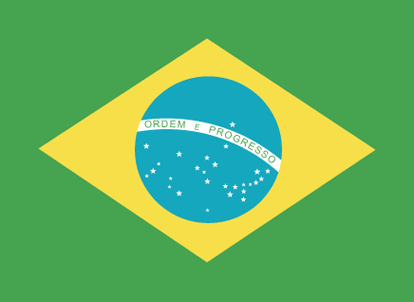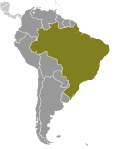
|
|
Advertisements:
People And SocietyNationality
Noun Brazilian(s)
Adjective Brazilian Ethnic groups
White 53.7%, mulatto (mixed white and black) 38.5%, black 6.2%, other (includes Japanese, Arab, Amerindian) 0.9%, unspecified 0.7% (2000 census) Languages
Portuguese (official and most widely spoken language) Note Less common languages include Spanish (border areas and schools), German, Italian, Japanese, English, and a large number of minor Amerindian languages Religions
Roman Catholic (nominal) 73.6%, Protestant 15.4%, Spiritualist 1.3%, Bantu/voodoo 0.3%, other 1.8%, unspecified 0.2%, none 7.4% (2000 census) Population World Ranking: 5
199,321,413 (July 2012 est.)
Note Brazil conducted a census in August 2000, which reported a population of 169,872,855; that figure was about 3.8% lower than projections by the US Census Bureau, and is close to the implied underenumeration of 4.6% for the 1991 census Age structure
0-14 years
26.2% (male 27,219,651/female 26,180,040) 15-64 years 67% (male 67,524,642/female 68,809,357) 65 years and over 6.7% (male 5,796,433/female 7,899,650) (2011 est.) Median age
Total 29.6 years
Male 28.8 years Female 30.5 years (2012 est.) Population growth rate World Ranking: 108
1.102% (2012 est.)
Birth rate World Ranking: 108
17.48 births/1,000 population (2012 est.) Death rate World Ranking: 153
6.38 deaths/1,000 population (July 2012 est.) Net migration rate World Ranking: 119
-0.09 migrant(s)/1,000 population (2012 est.) Urbanization
Urban population 87% of total population (2010)
Rate of urbanization 1.1% annual rate of change (2010-15 est.) Major cities - population
Sao Paulo 19.96 million; Rio de Janeiro 11.836 million; Belo Horizonte 5.736 million; Porto Alegre 4.034 million; BRASILIA (capital) 3.789 million (2009) Sex ratio
At birth 1.05 male(s)/female
Under 15 years 1.04 male(s)/female 15-64 years 0.98 male(s)/female 65 years and over 0.74 male(s)/female Total population 0.98 male(s)/female (2011 est.) Maternal mortality rate World Ranking: 104
56 deaths/100,000 live births (2010) Infant mortality rate World Ranking: 94
Total 20.5 deaths/1,000 live births
Male 23.9 deaths/1,000 live births Female 16.93 deaths/1,000 live births (2012 est.) Life expectancy at birth World Ranking: 123
Total population 72.79 years
Male 69.24 years Female 76.53 years (2012 est.) Total fertility rate World Ranking: 151
1.82 children born/woman (2012 est.) Health expenditures World Ranking: 43
9% of GDP (2009)
Physicians density
1.72 physicians/1,000 population (2007) Hospital bed density
2.4 beds/1,000 population (2009) Hiv/aids - adult prevalence rate
NA
Hiv/aids - people living with hiv/aids
NA
Hiv/aids - deaths
NA
Obesity - adult prevalence rate World Ranking: 52
11.1% (2003)
Children under the age of 5 years underweight World Ranking: 109
2.2% (2007)
Education expenditures World Ranking: 55
5% of GDP (2007)
Literacy
Definition
Age 15 and over can read and write Total population 88.6%Male 88.4% Female 88.8% (2004 est.) School life expectancy (primary to tertiary education)
Total 14 years
Male 14 years Female 14 years (2008) Unemployment, youth ages 15-24 World Ranking: 65
Total 17.8%
Male 13.9% Female 23.1% (2009)
Comments
Add a new comment: |
Advertisement
Members area
Brazil (Brasilia):
 
GPS points from Brazil (Brasilia)
|
||||||||

 Following more than three centuries under Portuguese rule, Brazil gained its independence in 1822, maintaining a monarchical system of government until the abolition of slavery in 1888 and the subsequent proclamation of a republic by the military in 1889. Brazilian coffee exporters politically dominated the country until populist leader Getulio VARGAS rose to power in 1930. By far the largest and most populous country in South America, Brazil underwent more than a half century of populist and military government until 1985, when the military regime peacefully ceded power to civilian rulers. Brazil continues to pursue industrial and agricultural growth and development of its interior. Exploiting vast natural resources and a large labor pool, it is today South America's leading economic power and a regional leader, one of the first in the area to begin an economic recovery. Highly unequal income distribution and crime remain pressing problems.
Following more than three centuries under Portuguese rule, Brazil gained its independence in 1822, maintaining a monarchical system of government until the abolition of slavery in 1888 and the subsequent proclamation of a republic by the military in 1889. Brazilian coffee exporters politically dominated the country until populist leader Getulio VARGAS rose to power in 1930. By far the largest and most populous country in South America, Brazil underwent more than a half century of populist and military government until 1985, when the military regime peacefully ceded power to civilian rulers. Brazil continues to pursue industrial and agricultural growth and development of its interior. Exploiting vast natural resources and a large labor pool, it is today South America's leading economic power and a regional leader, one of the first in the area to begin an economic recovery. Highly unequal income distribution and crime remain pressing problems.